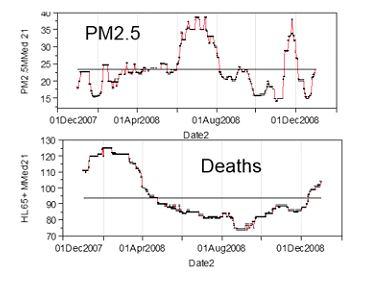
The US Environmental Protection Agency, the EPA, has been claiming that current air quality is causing deaths, thereby justifying the very expensive Clean Power Plan and other regulations.
Yet a new analysis of 1969-1974 data confirms the original finding that decreases in air pollution did not lead to reductions in deaths.
The data represent an "experiment" resulting from 1970 Federal "clean air" legislation, which mandated improved air quality in 257 counties and no intervention in another 276 counties. This quasi-experiment was a distinct step up from typical association studies. The total of 533 counties were used in the re-analysis and in both cases no significant changes in mortality were found.
The new analysis also formed subgroups of similar counties, called "clusters," and looked for an association of air quality with mortality within each cluster. The counties within a cluster can be thought of as statistical cousins; important variables that affect mortality, e.g. age, income, etc., are similar within a cluster so that these variables are effectively controlled out of the evaluation and we can focus on what is really important, like pollution.
If air quality was causing deaths, you should see an association within each cluster and any effect should also be consistent across clusters. As there was no overall reduction in mortality with improved air quality, causality is not supported. Yet the EPA does claim causation and even created a "one-size-fits-all" air pollution policy, even though various regions might not be similar at all. Since the association of air quality and mortality varied significantly across groups, a one-size-fits-all policy is not only lacking an evidence basis, it is doing more harm than good, by penalizing some areas without any benefit.
And the EPA knew of this negative finding in 2003, when the original study was published, and still ignored it. They could have asked for the data set and conducted their own analysis, but they chose to simply ignore it. If science-based policy-making is the goal, as stated by the government, The EPA should revisit the experiment they mandated via federal regulation and conduct their own analysis.
These re-analysis results, no effect of air quality on deaths, are also supported by two natural experiments. In June of 2002, forest fires in Canada blanketed the East Coast with smoke. Smoke can be tracked with PM 2.5, small particulate matter, so small that will pass through a 2.5 micron grid. PM 2.5 is used as a measure of air quality by the EPA. PM2.5 increased in Boston and New York City, yet daily deaths did not – but if air pollution caused deaths, and thousands would be saved by more regulations, then someone should have passed away.
The same no effect occurred in Los Angeles when lightning strikes started forest fires in May of 2008. Smoke, easily seen using satellite images, engulfed the city. PM2.5 levels increased verifying that the smoke had ground-level presence. PM2.5 increased, but again there was no increase in daily deaths. The re-analysis by Robert L. Obenchain and I, is upcoming in the journal Risk Analysis. The NYC and Boston analysis, which appeared in 2015, was done by researchers at Gradient. These non-effects are important because they should not be evident if air quality is causing deaths.
Image: Wikipedia
Both the old and new analyses can be verified, as data used in our re-analysis and from L.A. are available. These confirmed results undermine the claims that current air quality is causing deaths and so increased controls need to be mandated across the nation.
This article first appeared in Priorities magazine, which is sent free of charge to all American Council on Science and Health donors.



